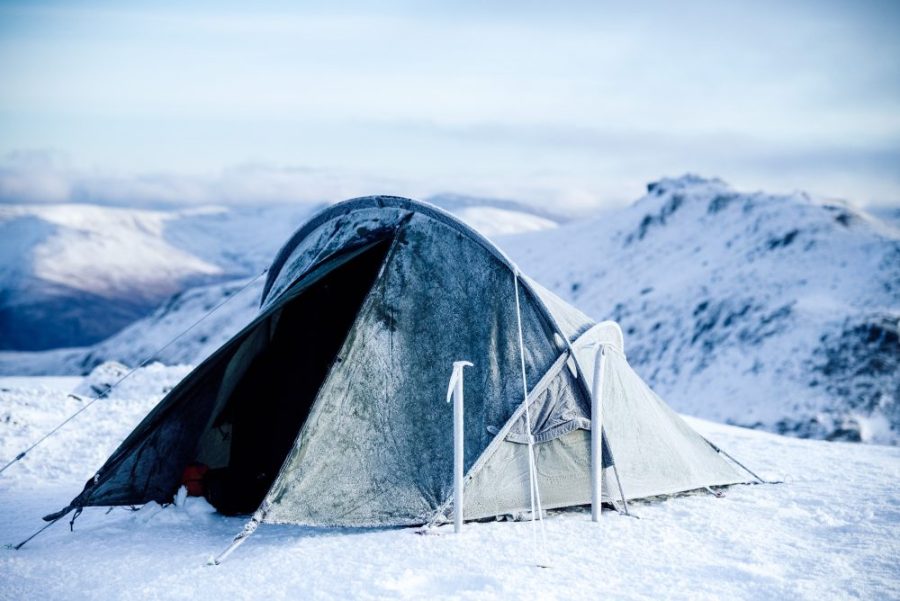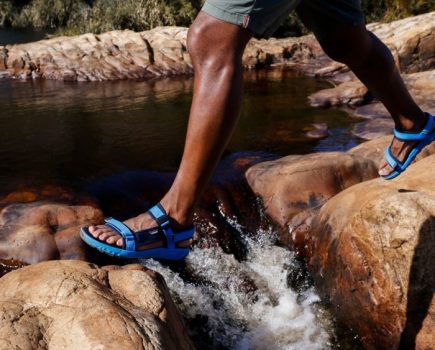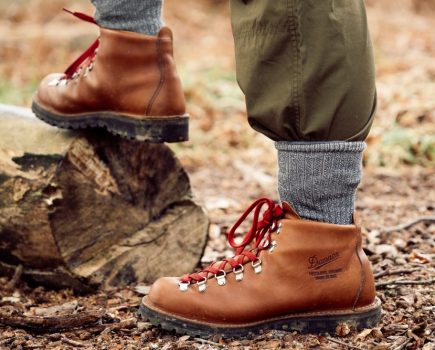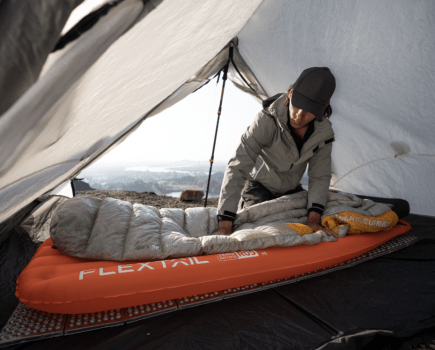Choosing the best two person tent to fit your needs can feel tricky. With such a huge range available on the market, it can be easy to get a little overwhelmed by choice. Two person tents come in a wide variety of designs, weight, price and intended usage. While some are designed for ultralight backpacking in remote areas, others are aimed more at car camping and occasional casual use.
Main image: Snugpak Scorpion 2 on Ben Lawers | Credit: Alex Roddie
Which tent you choose should be determined by your specific requirements, and it is worth remembering that a tent which excels in some situations may not in others. Ultralight tents are far easier to carry, but are likely to be expensive and made from less durable materials. Heavier tents may have more features and living space, but will be less comfortable to carry for days on end.
It is worth thinking carefully about where and how often you are planning to use the tent. If you only camp very occasionally, it is probably worth carrying some extra weight and avoiding a high price tag. On the other hand, if you are a regular long-distance backpacker and every gram counts, then it is worth spending more.
The best two person tents usually share some common features and qualities. The materials and construction should be durable throughout, and able to withstand ‘wear and tear’ even with heavy usage. Tents should be comfortable in a wide variety of conditions, allowing plenty of ventilation for warm and humid conditions, but also have the ability to perform well in wet weather and strong winds.
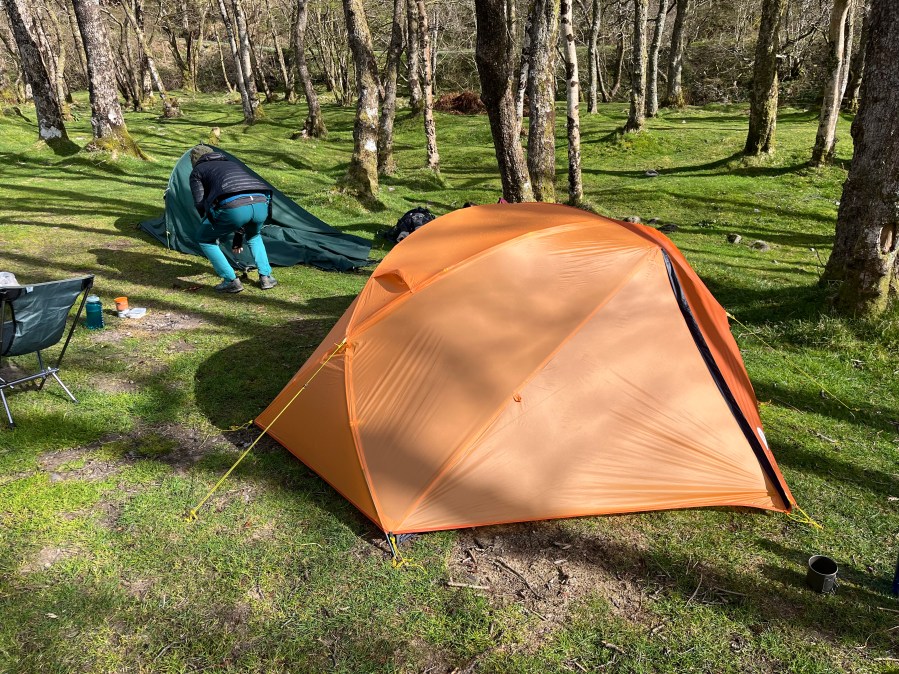
A freestanding (or semi-freestanding) design gives you plenty of flexibility when it comes to pitching the tent, and this helps you to pitch more easily on a variety of terrain. There should be enough space for two people to sleep without feeling cramped, but also some storage space for your gear. The lightest two person tents will sometimes be used by solo hikers as an alternative to a one person tent, for some extra living space.
Why you can trust The Great Outdoors
The Great Outdoors is here to help you make the most of your time outside. We have been helping people to explore from sea to summit, valley to mountain top for over 40 years. Our gear tests remain completely impartial. If you are wary of websites that only review brands that advertise with them, or sceptical of social media accounts always singing the praises of their latest freebie, you’ve come to the right place! Our reviews rank #1 for rigour, trustworthiness, and independence, and our gear testing team is the most experienced in Britain. With over 200 years’ experience between us, we are professional mountain leaders and instructors, wildlife photographers and rangers, outdoor authors, guidebook writers and trail addicts.
Jump down to the bottom of this article for our detailed guide on what to look for when buying a 2 person tent. We’ve covered everything from the pros and cons of inner-pitched-first tents versus outer-first ones through to things like hydrostatic heads and breathability ratings.
The best 2 person tents we’ve reviewed
We’ve also looked at the best one-person tents for backpacking if you don’t need the extra space a two-person tent will offer or the best family tents if you’re after something a lot bigger and slightly more luxurious. For those on a budget, here’s a round up of the best value tents we’ve tested.
| Quick List |
|---|
| Best in Test 2025: Sierra Designs Litehouse 2 (available from sierradesigns.com) |
| Best in Test 2024: Vango F10 Xenon UL 2 Plus (available from LD Mountain Centre) |
| Best value: Highlander Respite 2 (available from highlander-outdoor.com) |
| Lightest in test: MSR Freelite 2 (available from cascadedesigns.com) |
| Best for winter use: Hilleberg Allak 2 (available from Ellis Brigham) |
Best for stargazing
Sierra Designs Litehouse 2
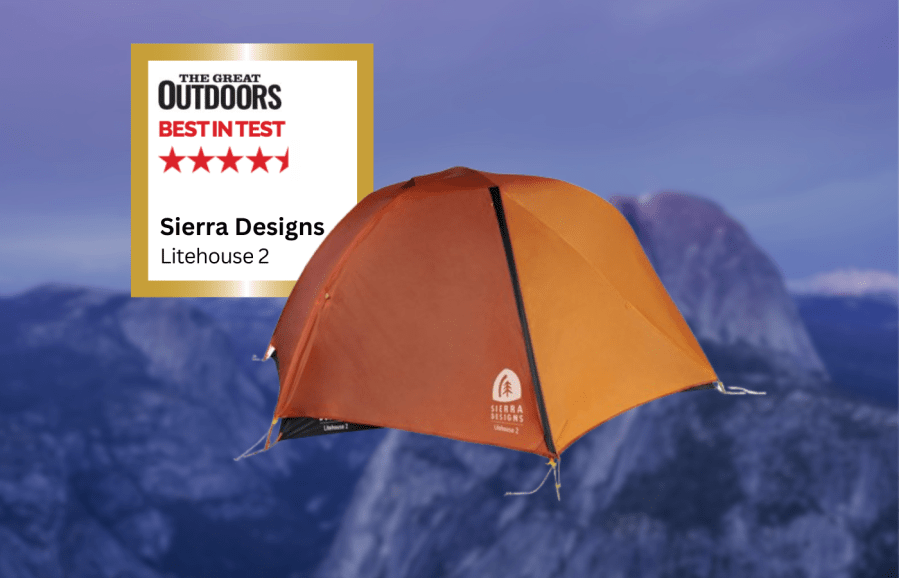
James Roddie’s Best in Test
Overall the Litehouse 2 trikes an impressive balance between low weight, comfort and price.- lightweight
- PFC free
- eExcellent balance between weight and comfort
- thin groundsheet material
| Quick specs | |
|---|---|
| Price: $399.95 / £399.99 Weight: 1.54kg (including storage bag) Pitching: Inner and flysheet separately (Inner first) Flysheet: 15D ripstop nylon. 1200mm HH. Inner: 15D ripstop nylon. 1200mm HH. Groundsheet: 15D ripstop nylon. 1200mm HH. Poles: 8.5mm aluminium Pegs: 10 Y profile pegs Porches: 2 Inner dimensions: 127cm (W) x 208cm (L) x 106cm (H) sierradesigns.com |
Sierra Designs make excellent tents and the Sierra Designs Litehouse 2 is a fine example of this. Weighing a total of 1.54kg this is a very lightweight two person tent, and I was impressed by the level of comfort and spaciousness it provided.
The two porches give a decent amount of external storage space, and inside there are two stash pockets by your head, and a very large stash pocket in the roof of the inner. I found the roof pocket really handy for storing clothing, and it provides a useful spot to place a headtorch to light the tent. The ‘Moon Roof’ design allows the flysheet to be rolled back half-way for ventilation on hot nights. Apart from the bathtub groundsheet, the inner is formed entirely from see-through mesh, meaning this is a great tent for watching the night sky.
Read more: James’ full Sierra Designs Litehouse 2 review
Best for porch space
Vango F10 Xenon UL 2 Plus
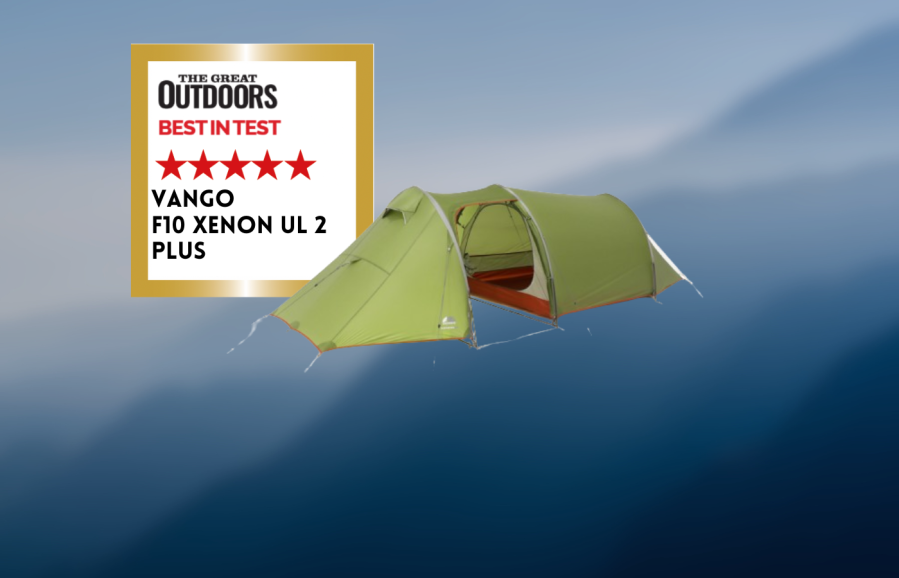
Alex Roddie’s Best in Test
lthough this tent is designed for four-season use, at a low weight it’s an attractive choice year round. And the price of £410 makes it even more attractive. Highly recommended.- Value for performance and weight
- Living space
- Massive porch
- Ease of snow pitching
- Lower-spec fabrics and poles
| Quick specs | |
|---|---|
| Price: £410 Weight: 2.11kg Pitching: fly first Flysheet: 15D Nylon flysheet with a silicone coating on the outer and a PU coating on the inner. Inner: 15D nylon Groundsheet: 70D nylon PU 5,000mm HH Poles: 7.9mm aluminium alloy Pegs: 19x alloy C shaped, 2x pin Porches: 1 Inner Dimensions: 130x230xx100cm vango.co.uk |
The Vango F10 Xenon UL 2 Plus is a lightweight tent that offers exceptional performance, weighing only 2.11kg. Its lightweight materials and poles contribute to its lightweight design, which may affect durability in the long term. The tunnel tent features Gothic arch architecture for added strength and has many adjustable pegging points and guylines to counteract the lightweight poles. It is one of the best tents tested for pitching on snow and comes with basic but serviceable pegs. The tent offers good resistance to high winds when pitched tail to wind, though less than the Hilleberg Allak. The interior living space is generous, with ample room for two. Designed for four-season use, this tent is an attractive choice year-round at a low weight of £410. Highly recommended.
Read more: Alex’s full Vango F10 Xenon UL 2 Plus review
Best for winter use
Hilleberg Allak 2
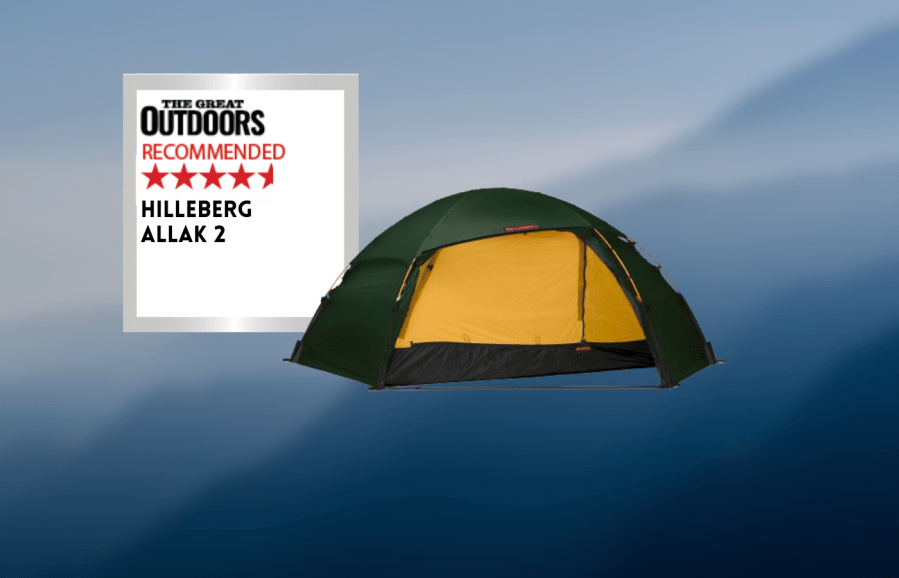
Alex Roddie Recommends
The price and weight are high, but so are the quality and performance. If you need a two-person shelter for regular, reliable, long-term winter service, this is the one I’d choose.- Superb storm resistance
- Durability
- Ease of pitching
- Winter use
- High price
- Basic pegs
- Heavy
| Quick specs | |
|---|---|
| Price: £1,220 Weight: 3.3kg Pitching: inner and fly together Flysheet: 30D Kerlon 1200 nylon ripstop sil 5,000mm HH Inner: 30D ripstop nylon Groundsheet: 70D nylon PU 15,000mm HH Poles: 9mm aluminium Pegs: 12x alloy V angle pegs Porches: 2 Inner Dimensions: 120x225x105cm hilleberg.com |
The Hilleberg Allak 2 person tent is a sturdy three-pole dome design that is free-standing and can be pitched from any angle. It is the most stormproof tent tested and can withstand moderate snow loading. The tent has a high hydrostatic head for the groundsheet and thicker poles than most other tents tested. It is easy to pack into its oversized stuffsack. However, the included pegs are basic and some of the least usable, so it is recommended to replace them with better ones.
The tent’s price and weight are high, but the quality and performance make it a good choice for regular, reliable, and long-term winter service. The included pegs are some of the least usable of any tent tested, so it is recommended to replace them with better ones.
Read more: Alex’s full Hilleberg Allak 2 review
Lightest in test
MSR Freelite 2

James Roddie recommends
There is a lot to like here but there are some inevitable compromises to keep the weight so low.- extremely lightweight
- spacious for weight
- expensive
- condensation/dripping issues
| Quick specs | |
|---|---|
| Price: $464.95 / £569.99 Weight: 1.05kg (including stuff-sack) Pitching: Inner and flysheet separately (Inner first) Flysheet: 15D ripstop nylon 1200mm polyether urethane & silicone Inner: 10D polyester micro-mesh and 15D ripstop nylon 1200mm polyether urethane Groundsheet: 15D ripstop nylon 1200mm polyether urethane and PFAS-free DWR Poles: DAC NFL 8.7mm aluminium Pegs: 10 MSR needle pegs Porches: 2 Inner dimensions: 127cm (W) x 213cm (L) x 100cm (H) cascadedesigns.com |
The MSR Freelite 2 is an exceptionally lightweight 2 person tent. There is a lot to like here but there are some inevitable compromises to keep the weight so low. I was pleasantly surprised with overall spaciousness. The internal width of 127cm and length of 213cm are very similar to those found in considerably heavier 2 person tents. The floor is rectangular as opposed to tapered, and this really helps with space for two sleeping mats.
After rain, I found that water drips into the inner when you open the flysheet doors. This is due to the taper of the inner and the positioning of the doors, and I don’t see how this can be avoided. The flysheet doesn’t cover the majority of the head of the tent, in order to save weight. Instead there is a large waterproof panel in the inner. This does a great job of keeping rain out, but it is unfortunately susceptible to condensation.
At £569.99 this is an expensive tent, but overall this is a great option for ultralight backpacking without big compromises in comfort.
Read more: James’ full MSR Freelite review
Robens Lodge 2 Exp

James Roddie recommends
Overall this is a highly durable tent with some useful features, and it should withstand years of heavy use.- robust materials
- high hydrostatic head
- feature-packed
- heavy
| Quick specs | |
|---|---|
| Price: $357 / £265.99 Weight: 3.3kg (including storage bag) Pitching: Inner and flysheet separately (Inner first) Flysheet: 75D recycled polyester ripstop Inner: 68D polyester Groundsheet: 75D polyester 10,000mm HH Poles: 8.5mm anodised aluminium Pegs: 14 V profile Porches: 2 Inner dimensions: 125cm (W) x 225cm (L) x 100cm (H) robens.de/en-gb |
The Robens Lodge 2 Exp is a highly robust and feature-packed three season tent. At 3.3kg it is certainly quite heavy, so it is arguably best suited for use as a ‘base camp’ tent or for car-camping rather than long-distance walks. The materials are extremely sturdy throughout. 75D polyester on the flysheet and groundsheet will resist wear-and-tear for long term use, and there is a repair kit provided. This is a tent which performs well in bad weather.
Overall things feel quite spacious. The relatively wide cross pole allows the inner walls to be near vertical, and there is ample headroom for two people sitting upright. However the internal width is marginally narrower than some much less heavy tents. I would prefer a little more width for the weight premium. You can store a lot of gear in the two porches, and the low flysheet clearance helps to keep things dry.
I’m a big fan of the ventilation options on this tent. There are two large kickstand vents, and I really like that they can be adjusted from inside. Large mesh panels on the top half of the inner doors can also be opened for ventilation. Overall this is a highly durable tent with some useful features, and it should withstand years of heavy use.
Read more: James’ full Robens Lodge 2 Exp review
Highlander Respite 2

James Roddie recommends
Overall this tent has a lot to offer for its price. This is a good choice for weekend warriors looking for a robust two person tent where weight isn’t a primary consideration.- affordable
- robust materials
- very easy pitching
- weight
- no mention of sustainability credentials
| Quick specs | |
|---|---|
| Price: $242 / £179.99 Weight: 2.68kg (including storage bag) Pitching: Flysheet and inner as unit Flysheet: 75D, 210T Polyester ripstop 4000mm HH. Inner: 190T Polyester breathable mesh. Groundsheet: 190T Polyester 5000mm HH. Poles: 8mm aluminium Pegs: 14 Y profile pegs Porches: 1 Inner dimensions: 130cm (W) x 210cm (L) x 100cm (H) highlander-outdoor.com |
The Highlander Respite 2 is a two person tunnel tent weighing a total of 2.68kg. This is not a tent designed for ultralight adventures, and this is reflected in the robust nature of the materials. My first impression was that this tent felt more akin to those made by slightly more expensive brands. The design is a simple ‘2 hoop’ shape, tapering towards the foot. The poles are not colour-coded but it is immediately obvious where these go. I found pitching very quick and intuitive. The tent pitches as a unit out of the bag (or flysheet first) which is helpful for pitching in wet conditions.
I was impressed with how this tent stands up to poor weather. The flysheet and groundsheet both have a high hydrostatic head, the seams are taped, and rainwater sheds quickly off the rounded flysheet design.
The porch feels nicely spacious. The porch entrance is quite narrow, but this helps to keep the weather out if you are cooking in the porch with the door open. A small groundsheet is also provided for the porch, and there is a hanging line for clothes in the inner. Overall this tent has a lot to offer for its price. This is a good choice for weekend warriors looking for a robust two person tent where weight isn’t a primary consideration.
Read more: James’ full Highlander Respite 2 review
Snugpak Scorpion 2 IX WGTE
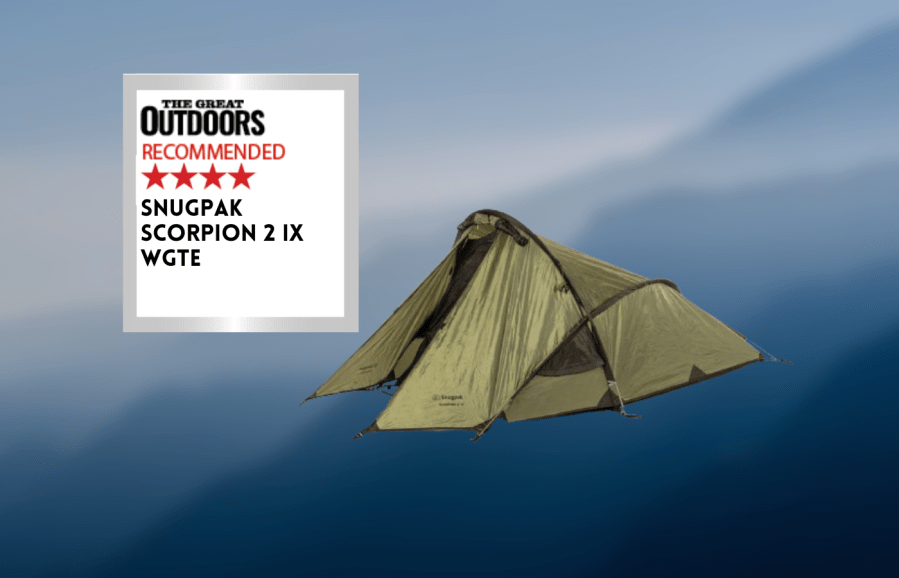
Alex Roddie Recommends
Despite minor downsides, the price is superb – and it’s capable of standing up to moderate winter Scottish conditions.- Fantastic value
- Decent winter performance
- Living space
- No double zips on doors
- Hard to repack
| Quick specs | |
|---|---|
| Price: £375 Weight: 2.8kg Pitching: fly first Flysheet: 26D polyester ripstop PU 5,000mm HH Inner: 50D nylon Groundsheet: 50D nylon PU 5,000mm HH Poles: 9mm 7001 aluminium poles Pegs: 16x alloy Y pegs Porches: 1 Inner Dimensions: 110x205x95cm snugpak.com |
The Snugpak scorpion 2 -person tent is advertised as four-season ready, similar to the Terra Nova Voyager, but heavier. It has a semi-geodesic structure and a single front-facing porch, but is heavier than the Voyager. The tent pitches flysheet first and then suspends the inner from the poles, which works well in bad weather but is slower to pitch than other tents. It has enough pegging points for winter use, but the two porch pegging points cannot be used with snow stakes.
The inner is dark and doesn’t let much light in, which could be beneficial for midsummer. The tent weighs 2.8kg, but the main downside is the cramped interior space, which is too short for comfort even when camping alone. The porch door has no double zip, making it unsuitable for ventilation. Despite these minor issues, the Snugpak scorpion tent is reasonably priced and can withstand moderate winter Scottish conditions.
Read more: Alex’s full Snugpak Scorpion 2 IX WGTE review
MSR Hubba Hubba Bikepack 2
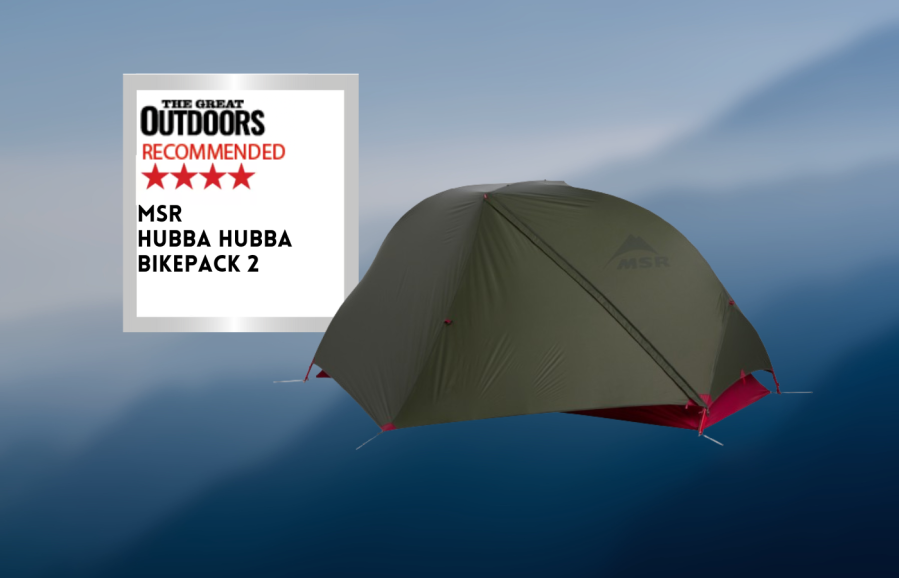
Alex Roddie Recommends
The (very thin) guylines easily slip under pressure. The included pegs also won’t hold in soft ground. It is, however, a good summer tent if the forecast is decent – especially for bikepackers.- Lightweight
- Spacious
- Gear loft
- Great for bikepacking
- Not the most durable or storm resistant
- Pegs don’t hold in soft ground
| Quick specs | |
|---|---|
| Price: £589.99 Weight: 1.75kg Pitching: inner first Flysheet: 20D nylon ripstop sil/PU 1,200MM HH Inner: 20D nylon ripstop, with 10D polyester mesh Groundsheet: 20D nylon ripstop PU 1,200mm HH Poles: 8.5mm DAC NSL aluminium poles Pegs: 8x alloy pins Porches: 2 Inner Dimensions: 127x213x107cm msrgear.com |
The MSR Hubba Hubba Bikepack 2 is a 2-person tent designed for bikepacking, featuring a clever stuffsack with attachments for bike handlebars. The tent has a variant dome design with a single apex pole that splits into a Y shape at both ends and a short tension pole at the top for improved living space. The tent’s inner pitch is less than ideal in bad weather but quicker than some other tested tents.
The materials are thin and ultralight, with only 1,200mm hydrostatic head for the fly and groundsheet. This means moisture can show through the groundsheet under pressure and is less durable.
The tent has two porches and interior space is good, with a gear loft for drying wet gloves. The tent is designed for three-season use, but gusts above 25mph can cause the structure to deform and twist. The thin guylines and included pegs won’t hold in soft ground, making it a good summer tent for bikepackers.
Read more: Alex’s full MSR Hubba Hubba Bikepack 2 review
Sea to Summit Telos TR2 Plus
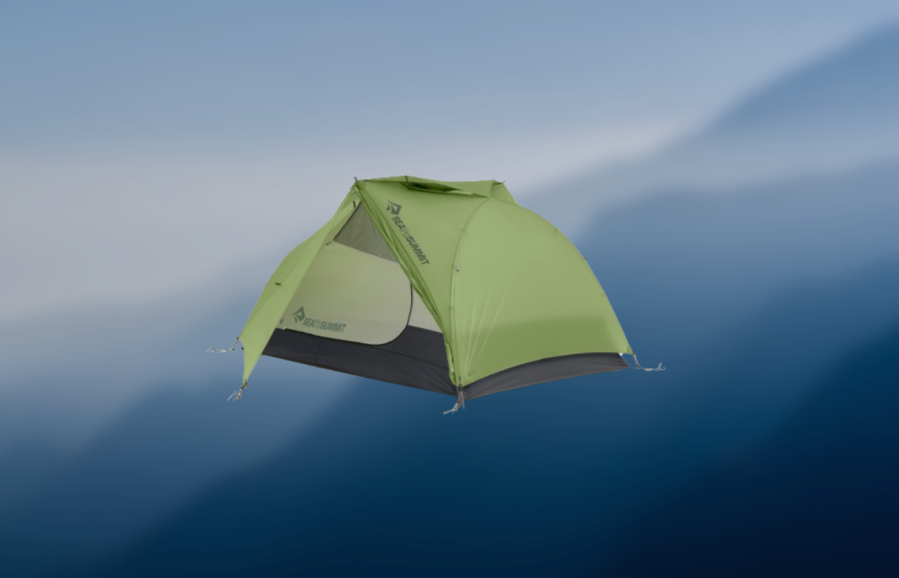
Alex Roddie’s verdict
The Telos TR2 Plus is a good tent with decent interior space for relatively settled weather. The price is a bit high for the performance, though.- Lightweight
- Excellent pegs
- Good ventilation
- Spacious
- Not a year round tent as claimed
- Not good in high winds
- High price for performance
| Quick specs | |
|---|---|
| Price: £615 Weight: 1.72kg Pitching: inner first Flysheet: 15D nylon ripstop sil/PU 1,200mm HH Inner: 20D nylon ripstop Groundsheet: 30D nylon ripstop 4,000mm HH Poles: 9.6 and 9.5mm Aluminum DAC TH72M Poles Pegs: 10x alloy Y pegs Porches: 2 Inner Dimensions: 134x215x105cm seatosummit.co.uk |
The Telos TR2 Plus is a year-round tent with a solid ripstop nylon inner, similar to the MSR Hubba Hubba 2. It features a dome layout with a central ridge pole, Y-shaped sections at either end, and a “Tension Ridge” at the top for more interior space. The tent comes in multiple stuffsacks that clip together, but the package is lengthy due to long pole sections.
The tent offers good interior space, including two decent porches, and good ventilation. The flysheet has a low hydrostatic head but is adequate, and the groundsheet is thin but does not show moisture under pressure. Wind resistance is slightly better than the MSR Hubba Hubba 2, but the price is a bit high for the performance.
The supplied Y-beam pegs are excellent. The Telos TR2 Plus is a good tent with decent interior space for relatively settled weather, but the price is a bit high for the performance.
Read more: Alex’s full Sea to Summit Telos TR2 Plus review
Terra Nova Voyager
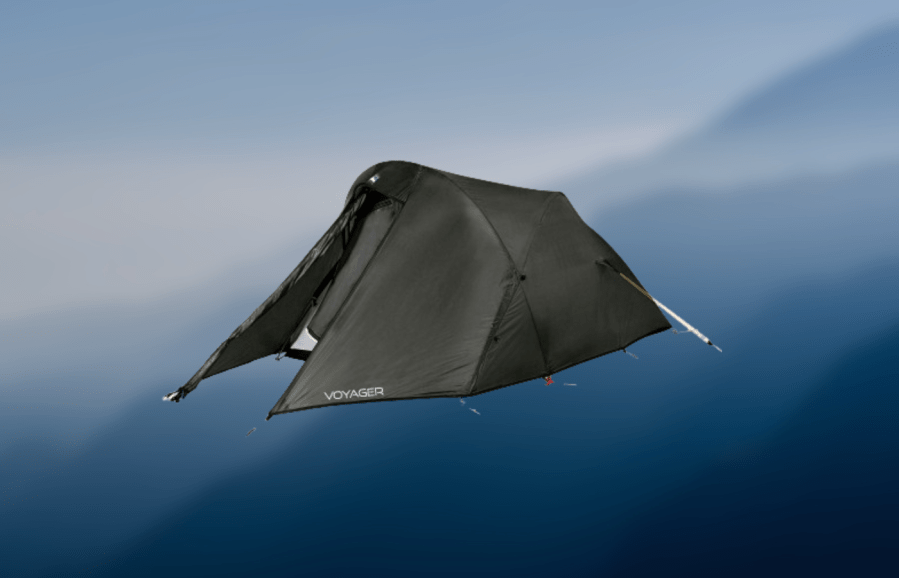
Alex Roddie’s verdict
In my opinion this is a robust and well-made three-plus-season tent made from high-quality materials, but it has limitations in winter, when it’s best reserved for less extreme conditions.- PFC-free fabric
- Hight quality materials
- Good pegs
- High price for performance
- Not genuinly four season
- Inner pitch first
- living space
| Quick specs | |
|---|---|
| Price: £740 Weight: 2.05kg Pitching: inner first Flysheet: 30D Watershed nylon ripstop sil/PU 5,000mm HH Inner: 30D ripstop nylon C0 Groundsheet: 70D Waterbloc nylon PU 10,000mm HH Poles: 8.7mm DAC NFL aluminium Pegs: 14x alloy Y pegs Porches: 1 Inner Dimensions: 90x206x106cm terra-nova.co.uk |
The Terra Nova Voyager is a 25-year-old 2-person tent with a semi-geodesic design, making it strong and lightweight. It was updated in 2023 with PFC-free fabrics. However, it struggles in high winds and can be deformed by big gusts. The tent could benefit from more guylines and thicker poles for better wind resistance. The pegging points lack adjustment, making them difficult to use with snow stakes. Spindrift can easily blow through the large rear vent and mesh panel. The fabric is great, especially the waterproof groundsheet.
However, it is an inner-pitch-first tent, which means the inner may get soaked or covered in snow before the flysheet can be tensioned. The interior living space is not generous, and the single porch is not ideal for cooking. Despite its strengths, the Terra Nova Voyager is not a genuine four-season tent.
Read more: Alex’s full Terra Nova Voyager review
How we test
James tested these tents in a variety of conditions in Spring in the Scottish Highlands. Conditions included moderately strong winds, clear nights with heavy dew, and some periods of heavy rain. James is 180cm tall with average width shoulders. All tents were weighed on James’s own scales. These reviews were originally published in the September 2025 issue of The Great Outdoors.
Alex tested these tents on a variety of short backpacking trips throughout the autumn and winter. Objectives varied from low-level camps to challenging winter summit sleeps in the full spectrum of weather, including blizzards. These reviews were originally published in the August 2024 issue of The Great Outdoors.
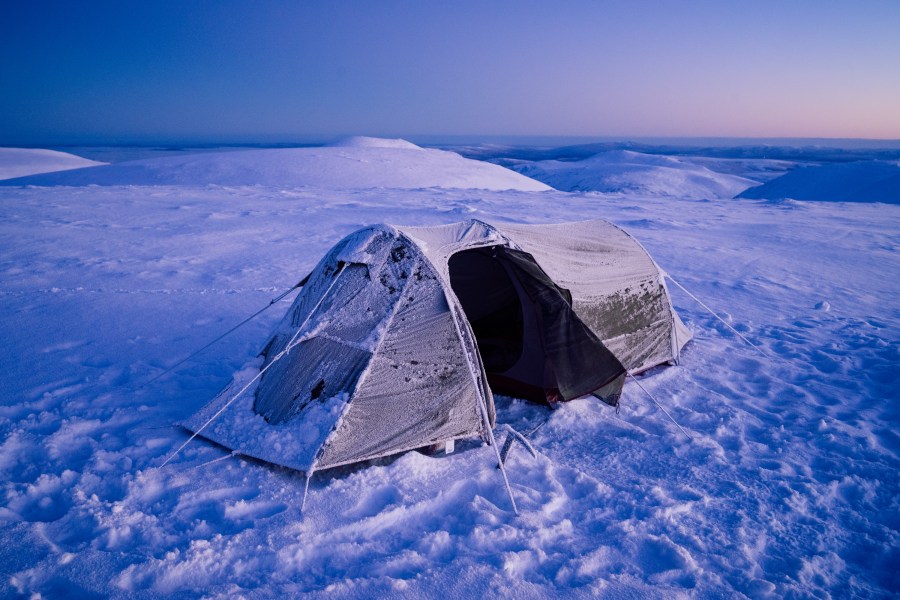
How to choose the best 2 person tent for you
Here are some of the crucial aspects to consider when you’re in the market for a new two-person shelter. These should all be weighed up against your own requirements, including the conditions you’ll be using the tent in and the type of trip too.
Comfortable fit
The length of a tent, the angle of the walls and the headroom all matter. If your sleeping bag pushes against the walls it may get damp from condensation. Walls that angle in sharply restrict living space, and being unable to sit up is uncomfortable. Note that inflatable mats can be thick and reduce headroom. For the most comfort the highest parts of the inner should extend enough that both occupants can sit up.
Pitch perfect
Pitching should be easy and quick. Tents may pitch as units or inner-first – few now pitch flysheet-first. The advantage of pitching as a unit is that it’s fast and the inner can’t get wet in rain. With inner- first-pitching tents you need to be able to erect it really fast in rain to minimise how wet the walls and floor get. An advantage of inner-first-pitching tents is that you can just use the inner on dry nights, which means no condensation, and it keeps bugs out. If the inner has a mesh roof you can see the stars too! Most tents come with pitching instructions but it does help to know the basics of how to pitch a tent before you set out to use your tent for the first time.
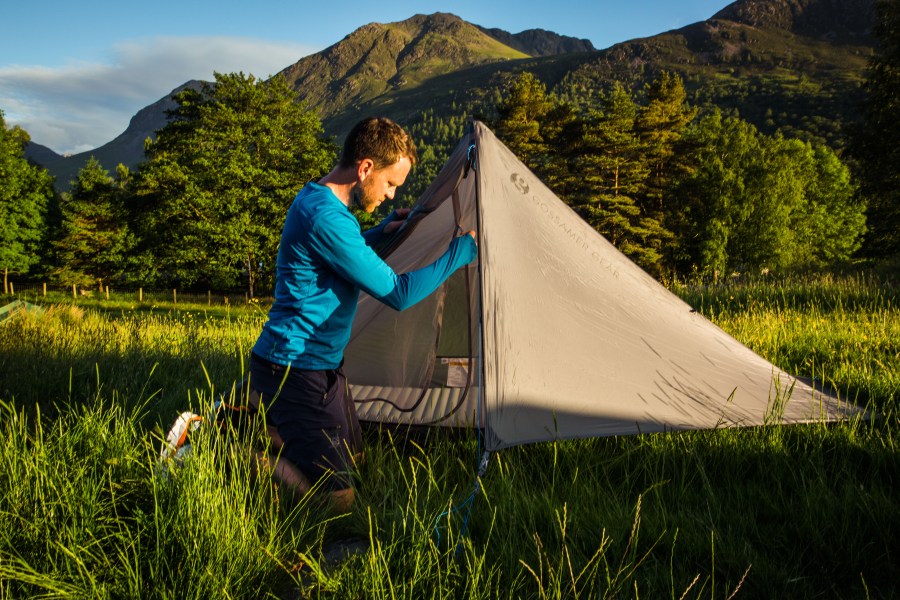
Weighty topic
To keep the weight down, some tents come with a thin groundsheet with a low ‘hydrostatic head’ (the height of a column of water it can support before it starts to come through). Often, makers advise the use of a footprint but only supply one as an extra, which means more cost and weight. The weights of the tents reviewed range from 1.18kg to 2.86kg. The weight is not necessarily an indicator of size, though – the two lightest tents are also two of the roomiest – but it’s often a sign of ultralight materials.
Tents suitable for use in the British hills should prioritise weather resistance, so it’s worth looking for down-to-the-ground flysheets and groundsheets with a high hydrostatic head. Tents that pitch as a unit are useful when the weather is bad too.
Flysheet
Flysheets vary widely in their weight and durability. Most are made from ripstop polyester or nylon. Nylon stretches more than polyester when wet, but it is stronger. The higher the ripstop denier (D) rating, the more resistant the material is to tearing. For waterproofing, flysheets tend to be either PU-coated or silicone-impregnated. Tents with PU coatings tend to be less expensive, but heavier and less-durable.
Inner
The inner tends to be made from material with a lower ripstop denier than the flysheet. Three season tent inners are normally comprised of a mix of breathable polyester or nylon panels, and mesh. Inners with large areas of mesh are better for breathability, but the risk of condensation dripping in from the flysheet is higher.
Groundsheet
Groundsheets vary widely in their durability and hydrostatic head (the measure of how much pressure can be applied to the fabric before it leaks). The lightest tents usually feature groundsheets made from very thin material with a low hydrostatic head – it is recommended to buy an optional groundsheet ‘footprint’ to protect the material if camping on rough or boggy ground with these tents.
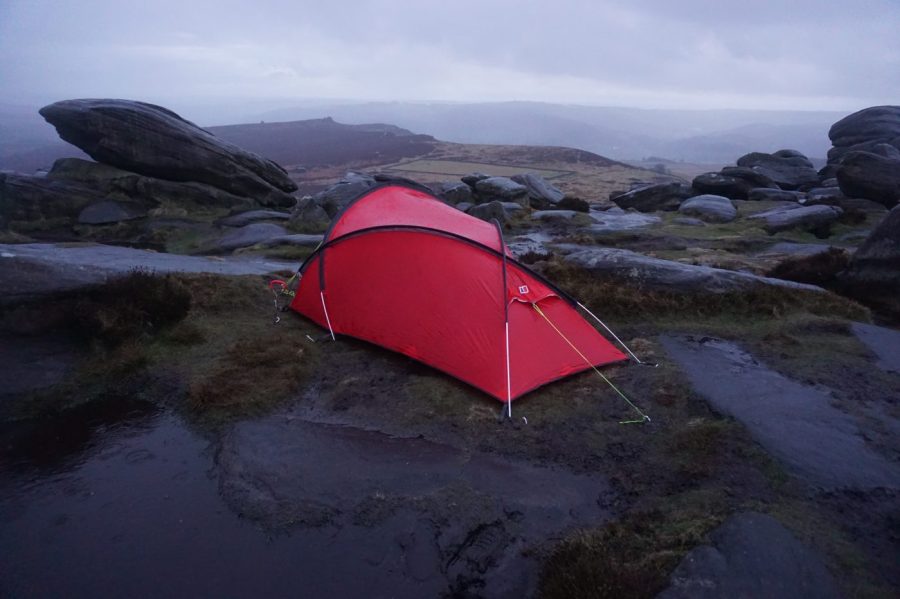
Materials
Silicone-coated fabrics are very light and durable and therefore they make for good flysheet materials. PU-coated ones are heavier for the same strength and don’t last as long but cost less. Polyester stretches less when wet than nylon but isn’t as strong. Silicone on both sides of a fabric reduces how much moisture it absorbs and how long it takes to dry as well as increasing its life. Some fabrics have silicone outside so rain runs off and PU inside so the seams can be taped.
For inner materials, breathable nylon or polyester tend to be good for resisting drips from condensation and keeping out breezes. These materials can be a bit hot in warm weather so optional mesh doors are useful. Mesh inners are cooler, but breezes can blow through; and if condensation drips they don’t keep it out as well as solid fabric.
Groundsheets need to be made from heavier fabrics than flysheets and have a higher hydrostatic head. Some makers advise using a footprint under a thin groundsheet.
Inner dimensions
The inner should be long enough that your sleeping bag doesn’t push against the end. Ideally there should be room for two full-size sleeping mats side by side. Headroom should allow both occupants to sit up comfortably.
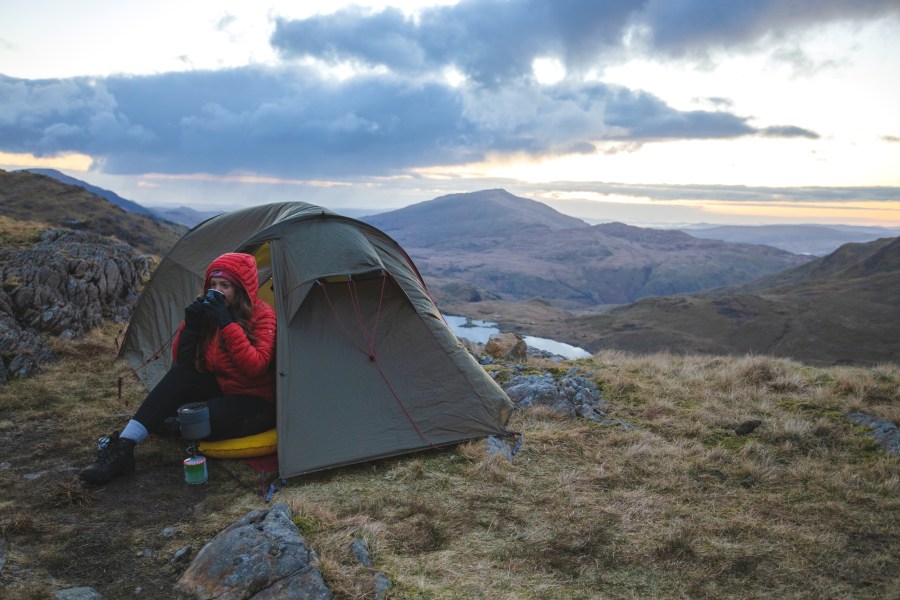
Poles, pegs and guylines
Poles should be easy and quick to attach, and colour-coded so it’s clear where each one goes.
A good set of pegs mixes thin ones for hard ground and wider ones for soft ground. The ones for key pegging points and guylines should be at least 15cm long. Packing extra pegs is advisable.
Guylines are the key to stability in strong winds. Extra guylines are useful in a big storm. Many tents have attachment points for these.
Porches and doors
The porch should be big enough for safe cooking and for storing wet gear and packs. Two porches mean each person has their own storage space and their own entrance.
Flysheet doors that can be opened in a number of ways are the most versatile. In good weather you can open them fully for easy access and views. In storms there should be a side away from the weather that can be opened if cooking. Two doors allow each person their own exit.
Ventilation
Versatile ventilation options are best for three season use. Kickstand vents are useful for being able to close in bad weather. Flysheet and inner doors which can zip open from the top also allow ventilation. Some tents feature vent ‘doors’ at the foot or head of the flysheet.
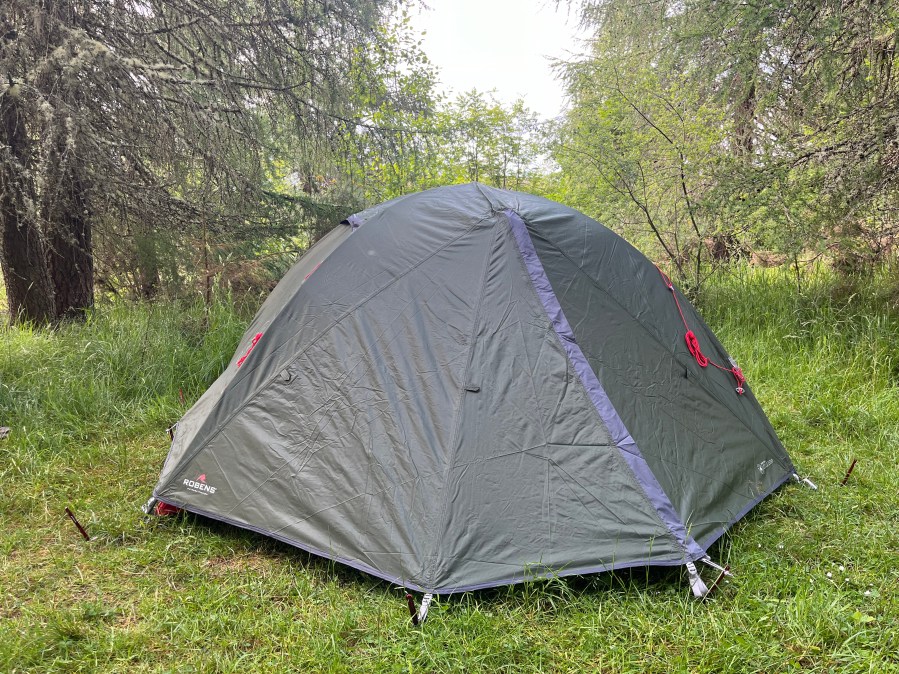
How to care for your tent
For a classic backpacking trip, your tent is one of your most important bits of kit, besides your trusty boots. And yet, its protective function leaves it vulnerable to wear and tear, from funky odours to broken zips, mould, mildew and even rips. Outdoor grime compromises DWR (durable water repellent) coatings and sand, smoke, dirt and even UV rays can contribute to degraded materials.
Tents can and, indeed, should be washed at least once a season – or more after heavy usage or soiling. But you should never wash or dry your tent in a machine. Machine washing can stretch or tear fabrics and damage components and drying your tent with heat in a dryer can compromise the DWR coatings. See our full guide on how to clean your tent for step-by-step advice and tips on how to store your tent.
Do you need a tent for backpacking?
The function of a tent is simple. Good tents are designed to protect you from the elements, primarily rain, wind or snow, so you and your gear stay dry and close by! It might not be so obvious here in Britain, but tents also protect campers from the sun in warmer climes. They also provide protection against critters as well as privacy. But there are alternatives to a tent.
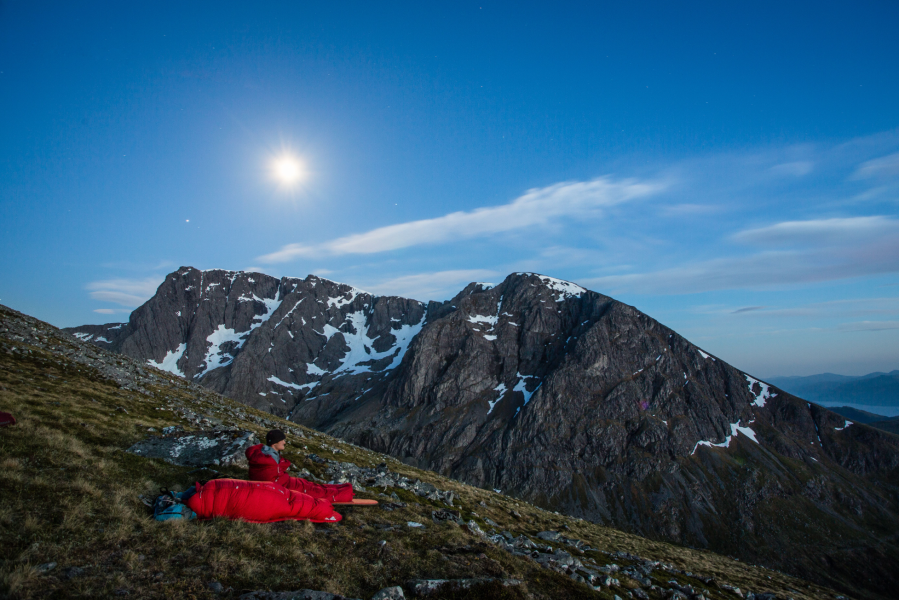
Behold the bivvy! This is probably the most popular alternative to using a tent on wild camps for a multitude of reasons. Bivvying is a lightweight way to stay warm through the night while remaining connected with your surroundings. Open to the elements, bivvying allows you to stargaze on clear nights and feel the dew on your face in the morning – if that’s your cup of tea.
Don’t fancy a night on the ground? Camping cots are sometimes favoured by those prone to aches and pains and who feel the chill of the cold ground. Simply, the small body-length structures raise you just a few inches off the ground so you still have the experience without the extra shivers.
Others prefer to hook up a camping hammock between the bows of trees. With room for two, and plenty of space for insulated sleeping bags. Sometimes, hammocks come with in-built insulation so can make for a very peaceful night as Mother Nature rocks you to sleep.
While these solutions give you the feeling of freedom outdoors, there is a halfway house between the closed-off structure of a tent and being totally open to the elements above you in a bivvy. Throw in a tarp alongside a camping solution to keep you from getting too cold on the ground on a rainy evening and you’ve got yourself a very cosy camp. Tarps are cost-effective camping kit. Much cheaper than tents, tarps still provide you with protection from rain, but give you easy access, ventilation, space and the view.

